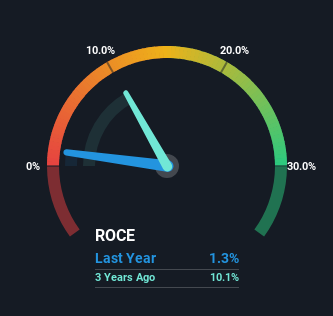Capital Allocation Trends At Keysino Separation Technology (SZSE:300899) Aren't Ideal

There are a few key trends to look for if we want to identify the next multi-bagger. Ideally, a business will show two trends; firstly a growing return on capital employed (ROCE) and secondly, an increasing amount of capital employed. If you see this, it typically means it's a company with a great business model and plenty of profitable reinvestment opportunities. Although, when we looked at Keysino Separation Technology (SZSE:300899), it didn't seem to tick all of these boxes.
What Is Return On Capital Employed (ROCE)?
Just to clarify if you're unsure, ROCE is a metric for evaluating how much pre-tax income (in percentage terms) a company earns on the capital invested in its business. Analysts use this formula to calculate it for Keysino Separation Technology:
Return on Capital Employed = Earnings Before Interest and Tax (EBIT) ÷ (Total Assets - Current Liabilities)
0.013 = CN¥8.5m ÷ (CN¥722m - CN¥61m) (Based on the trailing twelve months to September 2023).
Therefore, Keysino Separation Technology has an ROCE of 1.3%. In absolute terms, that's a low return and it also under-performs the Machinery industry average of 6.0%.
View our latest analysis for Keysino Separation Technology

Historical performance is a great place to start when researching a stock so above you can see the gauge for Keysino Separation Technology's ROCE against it's prior returns. If you're interested in investigating Keysino Separation Technology's past further, check out this free graph covering Keysino Separation Technology's past earnings, revenue and cash flow.
What The Trend Of ROCE Can Tell Us
On the surface, the trend of ROCE at Keysino Separation Technology doesn't inspire confidence. Around five years ago the returns on capital were 23%, but since then they've fallen to 1.3%. Given the business is employing more capital while revenue has slipped, this is a bit concerning. If this were to continue, you might be looking at a company that is trying to reinvest for growth but is actually losing market share since sales haven't increased.
On a related note, Keysino Separation Technology has decreased its current liabilities to 8.5% of total assets. So we could link some of this to the decrease in ROCE. What's more, this can reduce some aspects of risk to the business because now the company's suppliers or short-term creditors are funding less of its operations. Since the business is basically funding more of its operations with it's own money, you could argue this has made the business less efficient at generating ROCE.
The Key Takeaway
We're a bit apprehensive about Keysino Separation Technology because despite more capital being deployed in the business, returns on that capital and sales have both fallen. Long term shareholders who've owned the stock over the last three years have experienced a 45% depreciation in their investment, so it appears the market might not like these trends either. That being the case, unless the underlying trends revert to a more positive trajectory, we'd consider looking elsewhere.
Since virtually every company faces some risks, it's worth knowing what they are, and we've spotted 4 warning signs for Keysino Separation Technology (of which 2 shouldn't be ignored!) that you should know about.
If you want to search for solid companies with great earnings, check out this free list of companies with good balance sheets and impressive returns on equity.
Valuation is complex, but we're here to simplify it.
Discover if Keysino Separation Technology might be undervalued or overvalued with our detailed analysis, featuring fair value estimates, potential risks, dividends, insider trades, and its financial condition.
Access Free AnalysisHave feedback on this article? Concerned about the content? Get in touch with us directly. Alternatively, email editorial-team (at) simplywallst.com.
This article by Simply Wall St is general in nature. We provide commentary based on historical data and analyst forecasts only using an unbiased methodology and our articles are not intended to be financial advice. It does not constitute a recommendation to buy or sell any stock, and does not take account of your objectives, or your financial situation. We aim to bring you long-term focused analysis driven by fundamental data. Note that our analysis may not factor in the latest price-sensitive company announcements or qualitative material. Simply Wall St has no position in any stocks mentioned.
About SZSE:300899
Keysino Separation Technology
Keysino Separation Technology Inc. consults, design, manufactures, installs, commission, and maintains membrane separation equipment in China and internationally.
Flawless balance sheet low.

